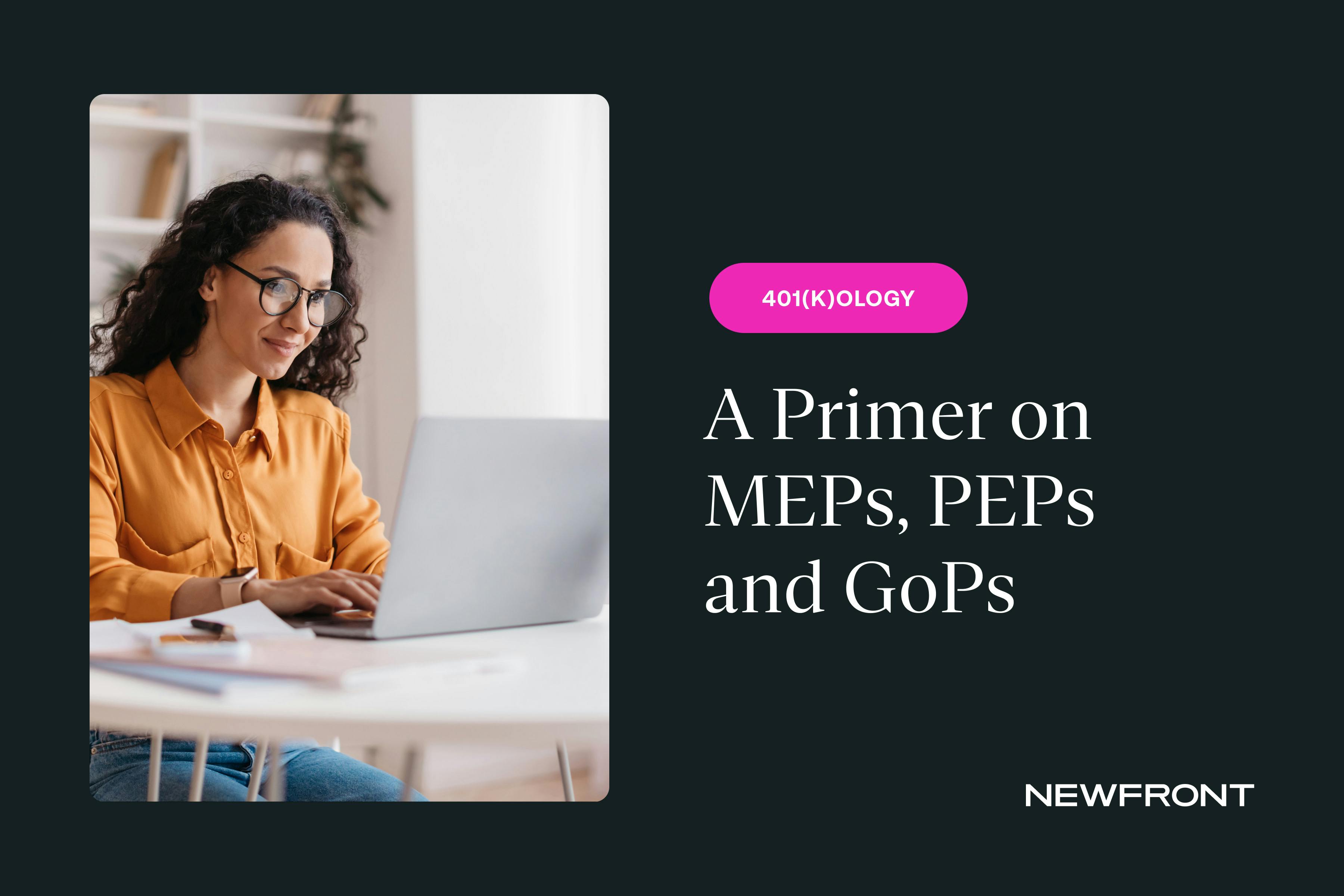401(k)ology – A Primer on MEPs, PEPs and GoPs
By Joni L. Jennings, CPC, CPFA™ | Published March 4, 2024

The Setting Every Community Up for Retirement Enhancement Act (SECURE Act 1.0) enacted at the end of 2019 established new retirement plan types, including Pooled Employer Plans (PEPs) and Defined Contribution Group of Plans (GoPs). It also ratified the existence of “open” Multiple Employer Plans (MEPs), which had been used by many service providers without formalized reporting requirements. The goal of these changes was to expand retirement coverage to more workers across the U.S. As a result of the new and expanded plan types, the Form 5500 series was updated to accommodate reporting requirements for plans maintained by more than one employer.
The SECURE Act 1.0 provided new simpler and easier paths for unrelated employers to participate in the same retirement program with common service providers. Before SECURE Act 1.0, only quasi-related employers could sponsor a Multiple Employer Plan (MEP). The addition of new combined retirement plan arrangements required changes to the Form 5500 and these changes were phased in between 2020-2023.
Characteristics of MEPs, PEPs and GoPs
Multiple Employer Plans (MEPs):
Shared Plan Sponsorship: MEPs have some common business nexus or commonality among the participating employers. MEPs involve multiple unrelated employers participating in a single retirement plan. Corporate MEPs require some overlapping ownership. For other MEPs, there may be a common association (e.g., trade association).
Reduced Administrative Burden: By pooling resources and administration, MEPs can potentially reduce the administrative burden and costs for each participating employer.
Economies of Scale: Participants may benefit from economies of scale in terms of investment options, administrative costs, and other plan expenses.
Compliance Oversight: MEPs may have centralized oversight for compliance matters, helping to ensure that all participating employers meet regulatory requirements.
Potential Risk Sharing: Employers generally share decision making over the named fiduciaries, plan service provider, plan administrator and investments.
Employee Service Crediting: Employee service with any employer in the MEP counts toward vesting if change employment to another employer within the MEP.
Form 5500: A single Form 5500 is filed for the plan by the primary sponsor. Participating employers are identified on Schedule MEP.
Large Plan Audit Cost: A single Independent Qualified Plan Accountant opinion (IQPA) required for the plan, allows the cost to be spread across participating employers.
PEO-Type “Open” MEPs
Plan Sponsorship: Generally, there is no commonality between adopting employers except for the payroll provider or plan service provider. Common in payroll sponsored or PEO type plans.
Reduced Administrative Burden: By pooling resources and administration, MEPs can potentially reduce the administrative burden and costs for each participating employer. The master plan document is sponsored by the plan service provider; each adopting employer has an agreement, typically with very limited options.
Economies of Scale: Limited to provider administration, recordkeeping and investments offered.
Compliance Oversight: MEPs may have centralized oversight for compliance matters, helping to ensure that all participating employers meet regulatory requirements.
Form 5500: A single Form 5500 filing is submitted by the provider as a Direct Filing Entity (DFE). Adopting employers are reported on Schedule MEP.
Large Plan Audit Cost: Single IQPA report for the plan provided by DFE (costs included in overall plan administration fees). MEPs with less than 1,000 participants on the first day of the plan year are exempt from potentially expensive audit requirements, provided no single employer has more than 100 participants.
Pooled Employer Plans (PEPs):
Multiple Employers Under One Plan: PEPs are a type of MEP that allows unrelated employers to participate in a single defined contribution retirement plan, known as a pooled employer plan.
Designated Pooled Plan Provider (PPP): PEPs must have a designated PPP responsible for administering the plan and fulfilling certain fiduciary duties. The PEP provider must be registered with the Department of Labor and the Internal Revenue Service as a PPP.
Streamlined Administration: PEPs aim to streamline plan administration and compliance by consolidating administrative tasks and responsibilities under the PPP. PEPs must be a 401(k) Plan.
Fiduciary Liability Mitigation: The PPP assumes fiduciary responsibilities related to the plan's administration and investment management, potentially reducing the fiduciary liability for participating employers. The PPP is the named Plan Administrator and fiduciary (corporate trustee). The employer retains the fiduciary duty to prudently select and monitor the PPP.
Enhanced Access to Retirement Plans: PEPs aim to expand access to retirement plans for employees of small and medium-sized businesses by offering a simplified and cost-effective option.
Form 5500: One Form 5500 submitted by the PPP as a Direct Filing Entity (DFE), with Adopting Employers identified on Schedule MEP. There is asingle IQPA report for the plan provided by DFE (costs included in overall plan administration fees). PEPs with less than 1,000 participants on the first day of the plan year are exempt from potentially expensive audit requirements, provided no single employer has more than 100 participants.
Defined Contribution Group of Plans (GoPs):
Sponsorship: The GoP approach allows completely unrelated employers to join the group of plans. GoPs are a collection of single employer plans that are required to have the same trustee, plan administrator, fiduciaries, plan investment menu and the same plan year.
Flexibility in Plan Design: Because the GoP is a collection of single employer plans, they offer more flexibility in plan design than MEPs and PEPs, allowing employers to tailor retirement benefits to meet the needs of their workforce.
Form 5500: One consolidated Form 5500 filing, however each single employer plan that is part of the GoP will have individual reporting requirements on Schedule DCG.
Large Plan Audit Cost: The determination as to whether an IQPA report is required is based on the single employer’s participant count as reported on the individual Schedule DCG. Therefore, an audit report (if required) will be the responsibility of the single employer, not the GoP provider.
New Schedules MEP and DCG
A GoP is different from a Multiple Employer Plan (MEP) or a Pooled Employer Plan (PEP). MEPs and PEPs have different requirements and are reported on Schedule MEP.
For PEO-Type “Open” MEPs, PEPs and GoPs, a single Form 5500 will be filed by a sponsoring entity (known as a Direct Filing Entity or “DFE”), but the underlying participating employer information will be reported separately on one of the new schedules depending on the type of group arrangement. Schedule DCG and Schedule MEP have been added to report information for plans that may be part of a larger group or association of plans.
For MEPs covering quasi-related employers (e.g., corporate MEPs), the primary sponsor of the MEP will file the Form 5500 and each adopting employer of the MEP will be separately reported on Schedule MEP.
Schedule MEP – For “open” MEPs, this schedule will be filed by the DFE to report each of the adopting employer’s plan information. The DFE will report the type of plan arrangement (association plan, professional employer organization “PEO,” PEP or MEP) on Part I. The participating employer information is then reported in Part II and includes the name of the Participating Employer, the Employer Identification Number (EIN) of the Participating Employer, the percentage of total contributions to the MEP for the Participating Employer and the aggregate account balances of the participants attributable to that Participating Employer.
If the plan is a PEP, the PPP has additional reporting requirements in Part III of the form to indicate compliance with the registration requirements as a PPP.Schedule DCG – This schedule will be filed for each retirement plan that is part of the larger collection of plans in the GoP. The GoP provider (the DFE) will file a single Form 5500 with a Schedule DCG for each plan sponsor that participated in the GoP.
It is quite possible that some plans in the GoP will be subject to the large plan filer requirements while others are not because the Schedule DCG is relative to a specific retirement plan within the group, not the group as a whole. Plans within the GoP may file as a small plan filer as long as the participant count for that individual plan is below the 100-participant count threshold. Click HERE for more information on the new participant counting methodology effective for the 2023 Form 5500 filing season in 2024.
Conclusion
Expanding retirement plan coverage to more American workers is extremely important, and these new plan types added by Secure Act 1.0 make offering a plan more affordable and less time consuming for small employers. These new choices are bound to create some initial confusion about which new retirement program might be the best fit for your company and workforce. Finding the right provider and plan type for your employees depends on many factors including the size of the company, the industry, and the overall retirement and financial wellness goals you want to achieve.
Newfront’s Retirement Services team is a valuable partner to plans of all sizes. We understand the types of plans available and the differences between them so that you can focus on running your business. Let us know if we can help analyze your current retirement plan or assist in establishing a new one.
Email us at 401kHelp@newfront.com
Helpful Links:
Newfront Retirement Services, Inc. is an investment adviser registered with the U.S. Securities and Exchange Commission. Registration as an investment adviser does not imply any level of skill or training, and does not constitute an endorsement by the SEC. For a copy of Newfront Retirement Services disclosure brochure, which includes a description of the firm’s services and fees, please access www.investor.gov or click HERE for the disclosures on our website.

Joni L. Jennings, CPC, CPFA™
Chief Compliance Officer, Newfront Retirement Services, Inc.
Joni Jennings, CPC, CPFA is Newfront Retirement Services, Inc. Chief Compliance Officer. Her 30 years of ERISA compliance experience expands value to sponsors of qualified retirement plans by offering compliance support to our team of advisors and valued clients. She specializes in IRS/DOL plan corrections for 401(k) plans, plan documents and plan design.


